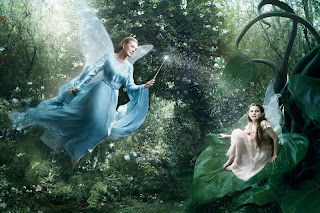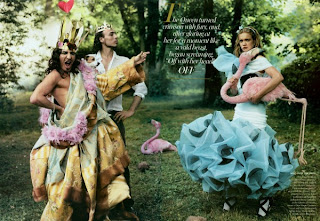Photographer Annie Leibovitz was born October 2, 1949, in Waterbury, Connecticut. In 1970 she took a job at Rolling Stone magazine. In 1983 she began working for the entertainment magazine Vanity Fair. During the late 1980s, Leibovitz started to work on a number of high-profile advertising campaigns. From the 1990s to the present, she has been publishing and exhibiting her work.
Fashion & Photography
Tuesday, May 1, 2012
Tuesday, April 24, 2012
Claude Monet's work of art, biography and a dress inspired from one of his paintings
Claude Monet, also known as Claude Oscar Monet, was the original founder and practitioner of the French Impressionist movement in painting. Some of his best known works include Impression, Sunrise (for which the movement was named), Water Lilies, and Haystacks.
Monet was born Claude Oscar Monet on November 14, 1840 in Paris, France to Claude-Adolphe, a grocery store owner, and Louise-Justine Aubree, a singer. As the younger of two sons, Monet's father hoped that he would continue the family grocer store business, but Monet had other ideas. To his father's dismay, Monet openly declared his love of art and his hopes of living life as an artist.
In 1851, at the age of eleven, Monet began his studies at the Le Havre school for the arts and began selling charcoal paintings to locals in the area. After studying under the watchful eye of Jacques-Francois Ochard for a few years, Monet met and befriended Eugene Boudin who helped Monet master oil paints and "plein air" techniques. In 1857, Monet's mother passed away and he left school to live with his aunt, Marie-Jeanne Lecadre.
On a visit to the Louvre in Paris, Monet observed painters mimicking the work of famous artists. Instead of copying styles of other painters, Claude Monet, who always traveled with his paints, sat by the window and painted the view. His life in Paris brought him closer to other painters, many of whom he befriended. One of these painters was Edouard Manet.
In 1861 Monet joined the First Regiment of African Light Cavalry in Algeria where he stayed for two years. Although he was originally supposed to remain in Algeria for seven years, his aunt petitioned for his return after he contracted typhoid. In exchange for his unfulfilled work with the Cavalry, Monet agreed to study art at a university. After trying his hand at academics, Monet began studying with Charles Gleyre in 1862 and met Pierre-Auguste Renoir, Alfred Sisley, and Frederic Bazille with whom Monet shared ideas on new, rapid painting techniques.
During his time with Gleyre, Monet met Camille Doncieux with whom he had a son, Jean, in 1867. Shortly thereafter, Monet ran into financial difficulties and attempted suicide in 1868. Camille helped him recover and they married in June of 1870.
When the Franco-Prussian War began in July of 1870, Monet and Camille decided to leave France and take refuge in England where Claude Monet studied other artists like John Constable and Joseph William Turner. Although his paintings were denied exhibition by the Royal Academy, Monet refused to give up and, instead, moved to Zaandam to continue his work. In the fall of 1871 Monet returned to France where he settled in Argenteuil near Paris.
During his time at Argenteuil, Monet focused more on developing his impressionistic style, painting the famous Impression, Sunrise in 1872 which later served to name the impressionist movement.
Camille fell ill in 1876 and never fully recovered. Although she eventually gave birth to their second son, Michel, Camille's body was weak and she passed away on September 5, 1879 from tuberculosis. Monet painted Camille Monet, on her death bed, a last tribute to his wife.
Camille's death was very difficult on Monet and he grieved heavily for several months. Eventually Monet became even more determined to create masterpieces and he started painting in groups and series. He and his children moved into the home of Ernest Hoshede, a patron of the arts. After Hoshede experienced some financial problems, Monet moved to Poissy with Hoshede's wife, Alice, and her six children and later to Giverny where Claude Monet planted a vast garden that later inspired his famous works featuring willows and water lilies. Although they'd been estranged for many years, Alice waited until after her husband's death to accept Monet's hand in marriage. They exchanged vows in 1892.
Monet continued his focus on series' paintings, using his garden as constant inspiration. After his wife's death in 1911 and Jean's death in 1914, Monet developed cataracts that affected his ability to see accurate colors. Claude Monet even went back and adjusted some of these colors after his surgery.
Claude Monet died in 1926 from lung cancer. He is buried in the cemetery of the Giverny church. His remaining family and heirs bequeathed his Giverny home and gardens to the French Academy of Fine Arts in 1966.
His work of art :
 For me his art is very special because the first dress that i designed was inspired from one of his paintings (the painting on your left) . I took a fragment from that painting and print it on the top of the dress. The bottom is in three colors, they represent the colors of the painting, 2 different colors of violet,light pink and the light green grass. The dress was presented at the Fashion week Skopje in April 2012! Here is a pic. from the dress and the show! :)
For me his art is very special because the first dress that i designed was inspired from one of his paintings (the painting on your left) . I took a fragment from that painting and print it on the top of the dress. The bottom is in three colors, they represent the colors of the painting, 2 different colors of violet,light pink and the light green grass. The dress was presented at the Fashion week Skopje in April 2012! Here is a pic. from the dress and the show! :)
Subscribe to:
Posts (Atom)




















































